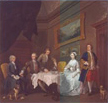John Martin, inventor of the apocalyptic sublime and all-round eccentric and interesting guy, has a GBAD show coming up at Tate Britain next year. In preparation, Tate’s conservation team are restoring a painting long thought to be lost to massive flood damage . . . Sarah Maisey is leading this project and will be reoprting on her progress as the show gets nearer!
John Martin’s Destruction of Pompeii and Herculaneum is a really dramatic picture showing the great volcano, Vesuvius, erupting over the ancient cities of Pompeii and Herculaneum. The painting was completed in around 1821 when people were very interested in big landscape pictures showing the destructive forces of nature.
 Here’s what Vesuvius looked like when it erupted in 1872.
Here’s what Vesuvius looked like when it erupted in 1872.
So perhaps it was fate when the painting itself also became the victim of a great natural disaster! On January 7 1928, the Thames got especially high and burst its banks (read more here). Water flooded into the basement at Tate Britain where the picture was being stored, completely submerging it. This isn’t at all good for paintings and the work was badly damaged. Many flakes of paint became detached from the surface and were lost. Parts of the canvas on which the picture was painted became really weak and tore apart, leaving a big gap in the image right where the heart of the volcano should be:
Not surprisingly, people at the time thought the painting was completely destroyed, so it was rolled up and forgotten about for many years. However, when the GBAD exhibition of works by John Martin was planned, the remaining fragments of the painting were unrolled. As conservators looked at it more than 80 years after the flood they thought that perhaps the work could be restored enough for it to be displayed. Conservators are people with special training that try and prevent artworks from getting damaged and fix them when they do. Repairing paintings can take a long time and conservators have to be very careful and patient when working with the fragile artworks.
The Destruction of Pompeii and Herculaneum is certainly a big job! The painting looks very dark because it is covered with layers of dirt and yellowed varnish which have to be carefully removed. All the loose paint has to be stuck back down and all the little losses will have to be ‘retouched’ with special paint (which is a bit like really careful colouring in!). But the really big task will be re-creating the missing section. Using original photographs of the damaged painting and another version of this same work as a guide, conservators are working out how best to fill in the gap so that the artwork can be displayed for the public.
Stay tuned for updates from Sarah and the conservation team!









What does art mean to you?
You can also join the debate on
Facebook
Twitter
Youtube